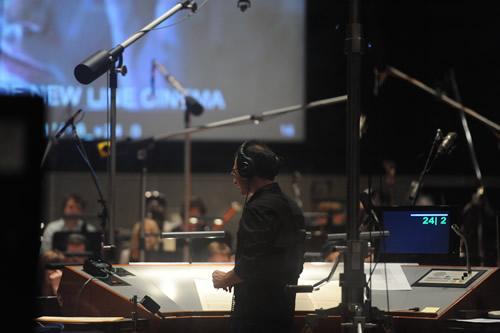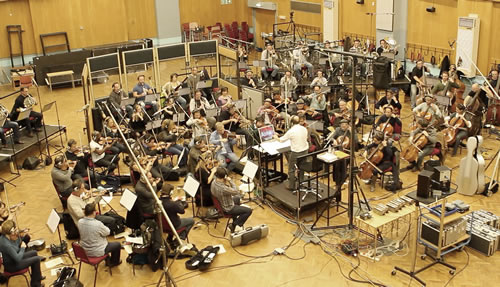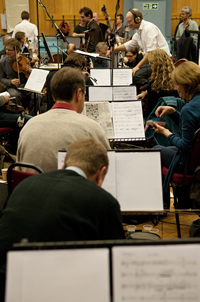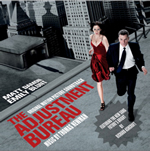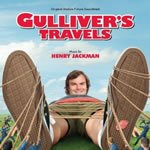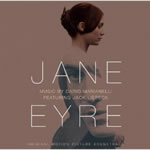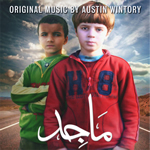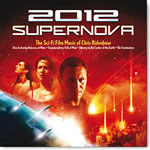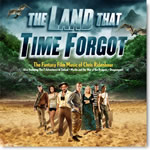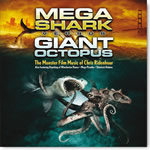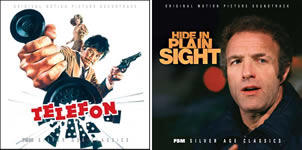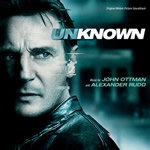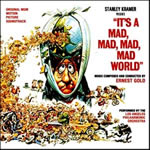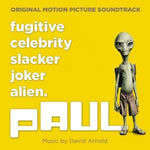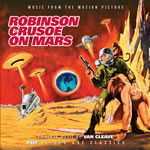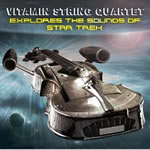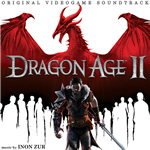
 |
Soundtrax: Episode 2011-03
March 24th, 2011By Randall D. Larson
Alex Heffes with music scoring mixer Joel Iawtaki at the mixing board during THE RITE scoring sessions.
Photo: Larry MahThe filmscoring career of British composer Alex Heffes (THE BRIDGE, THE LAST KING OF SCOTLAND) has turned dark recently, with one horror score in Mikael Håfström’s THE RITE (album released by Silva Screen Records; see review in column for Jan 21, 2011) and now, in collaboration with Brian Reitzel, Catherine Hardwicke’s RED RIDING HOOD, a poetic and somewhat Neil Jordonesque (à la COMPANY OF WOLVES perhaps) take on the girl-grandma-wolf fable.
Q: What kind of horror/fantasy movie is RED RIDING HOOD and what kind of music were you asked for?
Alex Heffes: If I had to put it into a genre I’d guess that RRH is probably more of a fantasy than a horror film. We knew from the outset that it didn’t want to be a typical ‘fairy-tale’ score. Catherine [Hardwicke, director] wanted something much more nuanced and dark.
Q: How did you come to work with Brian Reitzel on the score and what was the manner of your collaboration with him in achieving it?
Alex Heffes: Brian had been music supervisor on the film for some months, overseeing the creation of the new Fever Ray track for the film and setting the musical tone of the picture for Catherine. I was brought on during post to co-write the score with Brian. The idea was to combine our own different but complimentary styles to give the film something a bit unusual on its soundtrack.
Q: What were your initial conceptions for the sound palette of the music and how was that developed throughout the score?
Alex Heffes: Brian’s approach is very textural. He uses a lot of home-made weird and whacky instruments. We wanted to find a way of combining this approach with an orchestral score. The challenge was to try and make the two worlds mesh together. We tried various unusual orchestral tricks to make this happen. At one point we had some of the cello and bass players wedge Styrofoam cups into the bridge of their instruments to create a nasty type of analogue distortion. To create the ‘sound’ of the wolf we did a session with a ‘cello orchestra’ - 24 cellos, 10 double basses and 5 bass trombones. It was pretty awe-inspiring standing in front of them on the scoring stage!
Q: What kind of temp score did the film initially have - and how did that affect the score you and Brian would compose?
Alex Heffes: Some of the original temp score was made up from textures that Brian had created with his instruments. We had three very talented music editors on the film. They also contributed very importantly to the whole process.
Alex Heffes conducting the orchestra for THE RITE.
Photo: Larry MahQ: What elements of the film initially spoke to you as something the score should hinge upon, and how did the score develop from there?
Alex Heffes: Working with Brian was a lot of fun and very creative. Catherine encouraged us to be as crazy as we liked which is not something that happens every day. So the spirit of experimentation was probably the main driving force.
Q: What was most challenging for you on this score?
Alex Heffes: Getting it done in the time allotted! Most of the score (about 85 minutes) was written, orchestrated and recorded in under four weeks.
Q: Songs are also a large part of the movie’s musical design. How did the placement of songs in the film dictate how you would design and develop the dramatic score?
Alex Heffes: We derived the love theme from a song by The Big Pink that comes at the end of the picture. It was a nice challenge to tie in the score thematically to the song. Hopefully this gives a satisfying sense of continuity.
Q: Your previous score, for the horror film THE RITE, is very understated and deliciously creepy. How would you describe your approach to scoring that film?
Alex Heffes: I’m happy with that appraisal! Maybe add classic but modern as an aspiration. It was a great opportunity to score one of cinema’s all-time-greats at the peak of his career. Anthony Hopkins is really amazing.
Q: Both of these scores are spooky, scary, and rhythmically interesting. What do you feel is the responsibility and the opportunity of music in augmenting the scare factor in horror films like these?
Alex Heffes: I’m not sure music is going to make a film scary if it’s not already playing that on screen. It’s really a question of trying to draw out what’s on screen in a way the audience doesn’t see coming - you don’t want to ruin the jump when it comes...
Many thanks to Jo Carpenter for facilitating this interview. – rdl
The RED RIDING HOOD soundtrack has been released digitally by Water Tower Music. Separately, Goldenlane Music has issued a songtrack album
___________________________________________________________________________
This is abbreviated from Jeremy’s longer report of the scoring and recording of Killzone 3, a video game score composed by Joris de Man.“It’s all about expectation,” Joris says. He pauses, and sips from his Coca-Cola can. Joris, or Joe to his friends, is talking about his passion: music.
Responding, I ask if that’s why songs tend to finish with a sense of completion.
“Yes,” he answers. “But you want to delay that; it’ll heighten the resolution when it finally arrives.”
In hindsight, I wonder if he knew that this would be his own experience of Killzone 3’s music composition and eventual recording at Abbey Road Studios in London.
Joris de Man, Ivor Award winning music producer and composer, recently completed work on Guerrilla Games’ Killzone 3, a triple-A title for Sony’s PlayStation 3. The game is by all accounts polished, visual, and cinematic. It sports single player campaign mode, local co-op, and online multiplayer. Villains give speeches, and heroes fight heroically, despite all odds.
But stepping back to October of 2009, the view of this project is entirely different. That was when Joris signed the contract to begin work on the music for Killzone 3. Joris is no stranger to this franchise: as the Audio Director of the first Killzone game, he oversaw both the music and the sound design. His work can be heard in the sequel, Killzone 2, and the PSP incarnation of the series, Killzone: Liberation.
Since so much of the storytelling depends on the gamer, the music must be constructed carefully, like a puzzle, so that the pieces fit together in multiple ways.
When he worked on the first Killzone game, Joris was in-house at Guerrilla, based in The Netherlands. Now, October of 2009, he lives in the UK, working from the south coast, outside Brighton. Killzone 2 was released earlier in the year, February of 2009. By October Joris is excited to create the new score. The fine print says 80 minutes of music. To the layman, that’s less than the average film score length. But Joris and his wife Sam know to prepare for the inevitable big crunch, and the manic round-the-clock lifestyle that will escalate throughout the project. A large portion of that composing time will go toward the in-game music. Since so much of the storytelling depends on the gamer, the music must be constructed carefully, like a puzzle, so that the pieces fit together in multiple ways. If the player does one thing, the music must follow suit; if the player does something different, the music has to respond accordingly. Joris starts with the in-game and will work in conjunction with the game director so that the visuals, actions, and music all marry together seamlessly.
Joris begins his ‘sketches,’ which, like the visual equivalent, involves bare bone tracks with minimal detail: sometimes just with a piano line. Then he works in the detail.
Christmas comes and goes. In January 2010, Joris and Sam learn of a new category at the British Academy of Songwriters, Composers, and Authors’ Ivor Novello Awards. At this year’s 55th ceremony, for the first time in the Ivor Awards’ history, someone will receive an award for Best Original Videogame Score. When the nominations are announced, Killzone 2 has been nominated for its score. The excitement is palpable in the house even while Joris focuses on composing for Killzone 3. It’s not too long when Joris finds himself sitting at the Grosvenor House Hotel for the Ivor Novello Awards. British presenter Dom Joly opens the envelope for Best Original Videogame Score and says, “Ah, a name I can understand.” Joris exhales. He thinks his Dutch name doesn’t match that statement. Until it is read aloud: Joris de Man has won the Ivor Award for the Best Original Videogame Score for the very first year that the category exists.
Abbey Road is still six months away. And the next six months will be some of the hardest of Joris’s life. In September of 2010, just after Joris completed the in-game portion, (a whopping 55 minutes of music), Joris lost his mother. If you ask him if his music changed, he’ll hesitate before answering. But his answer is strong when it comes: “Yes.” And then, “Of course.” The remaining music to be composed was for the cinematic portions of the Killzone 3, and for the opening menu. This was the music that would be recorded with a live orchestra rather than created digitally.
On 19 October, 2010, Joris began a breakneck schedule of seven-day weeks. The cinematic portions of the game are key scenes where the story moves forward: moments where characters emote and grow, or where events take an unexpected turn. And when it came to the menu music, the initial expectation was for it to be energetic and imposing; very much in keeping with the earlier Killzone games. After some consideration and sketching, however, the piece took an unexpected turn of its own. Some would call the piece poignant. Perhaps it’s the solo violin layered over the string section. But by all accounts, the menu music was shaping up to be unique in the Killzone series. Early listeners have described the piece as inspiring, moving, and even epic.
Finally, exactly one month after Joris began composing for a live recording and over a year after beginning work on the title, Joris and the team met at Studio One, Abbey Road. It is now early on 19 November, 2010. The energy and tension are palpable. Jonathan Williams conducts. Behind the glass, Joris traces along the paper score with his finger as it is played. The session is a nine hour marathon, divided into three hour segments. The musicians have sandwiches beside their instrument cases. Between takes, they snack, or take drinks from water bottles. And you can hear their excitement for the pieces as they converse. The cimbasso player rarely gets such bold notes, for example. Those around him nod in agreement. The air feels almost electric, even into the evening.
Hour upon hour of work has funneled into this moment. Bows dance over strings in unison, and the players in the trombone section slide their plungers in and out; the conductor moves to the music with visible energy, animated by the notes that Joris has composed. It’s a breathtaking sight, entirely matching the depth of the music being performed. Abbey Road, Studio One, shapes the sound, spinning the volume and distilling it with wooden panels and measured distances. When the final piece is being recorded, the menu music serves as the end cap to an exceedingly emotional period. The booths are quiet during the two takes it requires to get the music down. The last notes are played, and Jonny Williams slowly lowers his arms and says nothing, leaving a second or two of silence at the end of the recording. Behind the glass, we’re holding our breath.
And then laughter. And clapping. Sam pushes the heavy door open, walks to Joris and hugs him. I can see the joy on his face. The performing musicians had only compliments to say about it. Joris looks contented. He and the team recorded 32 minutes of live orchestral music; in the following days, they recorded the choir and solo violin parts. On 26 November, they delivered the edited pieces to Guerrilla Games. The recording was produced by Rich Aitken and recorded by Abby Road Engineer Andrew Dudman. Jonathan Williams conducted both orchestra and choir and oversaw the score copying with the assistance of Irene Anderson. The 5.1 Mix was completed by Rich Aitken at Nimrod Studios, with additional percussion overdubs by Joris. Marc Canham produced the choir recording, and Abbey Road Engineer Sam Okel recorded. The Orchestra was brought together by Principle Bass Player and Fixer for the Nimrod Studio Orchestra, Stacey Watton.
Killzone 3 for PlayStation 3 was released in February with a Soundtrack album released on the PlayStation Network and included in Collector’s and Helghast editions of the game.
Thanks to Sam McCarthy for making this document available to Soundtrax and for allowing me to edit it to accommodate available space in this column. See my review of the Killzone 3 score in my Feb 28th column
_______________________________________________________________________________
New Soundtracks Releases of Note
THE ADJUSTMENT BUREAU/
Thomas Newman/Relativity Music Group (download)
The score for this speculative futuristic drama is full of the kind of Thomas Newmanisms that nobody does better than, well, Thomas Newman. This is both a good thing and a bad thing, as Newman continues to craft the kind of percussive orchestral textures and tonal rhythms that had defined his kind of scoring since AMERICAN BEAUTY. It’s a style that is both elegant and effective, but it’s also a pattern with little development or change in texture and hue. Intricate, minimalist piano riffs and rapid electric guitar plucking set the stage for expressive string cadences and contrapuntal flute filigrees. This is essentially a percussive action score interspersed with moments of tension and furtive anticipation, meager of melodies but strong in progressive tonal rhythms and drive, built of repetitive rhythmic patterns. Howard gives the film the cerebral tonality it needs (it’s based on a story by Philip K. Dick) while giving the beguiling romance between Matt Damon and Emily Blunt its sufficiently steamy musical eros. THE ADJUSTMENT BUREAU makes for satisfying listening on disc; allowing its rhythmic riffs to roam, reverberate, and recede into your brain is pleasant if not extremely provocative. Two very good rock songs by former Verve frontman Richard Ashcroft (one,” Are You Ready,” is from his new album, United Nations of Sound, the second, “Future’s Bright,” is a new song co-written with Howard for the movie) appear on the soundtrack, as does an incendiary remix of jazz diva Sarah Vaughn’s “Fever” which just won’t stop (and that’s a good thing).
GULLIVER’S TRAVELS/Henry Jackman/Varese Sarabande
Former Hans Zimmer/Remote Control protégé Henry Jackman (MONSTERS & ALIENS was his breakout solo score) has composed a splendid and frequently swashbuckling score for Rob Letterman’s comic retelling of the celebrate Jonathan Swift novel, with Jack Black as the intrepid adventurer who runs afoul of giant Brobdingnagians and miniscule Lilliputians alike. Jackman provides a richly bombastic and purposefully overblown score – kind of a musical incarnation of Jack Black’s manic performing style – which makes for a fine and fun album for your home stereos. He also supplies some elegant magisterial court music in “I Have Come To Court You,” and a melancholy love theme in “Folorn” which meets its richest reprise in “Persona Non Gtrata.” A sense of whimsy runs throughout much of the music, in keeping with Letterman’s (and Black’s) interpretation of Swift. At the same time, GULLIVER’S is a complicated score with a number of heavy orchestral themes to keep track of, and Jackman provides to be more than capable in conveying a stirring orchestral demeanor while staying within the realm of the familiar. The score reaches masterful epic proportions in its climax, with “The Island Where We Dare Not Go,” “Take Off That Dress and Let’s Get Outta Here,” and the 7-minute “Ein Roboterleben” conveying an adroit thematic choreography amid their challenging orchestral configurations, Jackman aided by a large team of orchestrators and a few additional composers of his own now. Like Jackman’s first solo score, GULLIVER’S starts out exciting and keeps right on charging, with a few asides for the respite of the court or the passion of love. It’s an enjoyable and satisfying score.
HAUNTED HONEYMOON/John Morris/La-La Land
While he’s composed some compelling dramatic film scores, most notably THE ELEPHANT MAN and Freddie Francis’ Burke-and-Hare horror film THE DOCTOR AND THE DEVILS (1985), John Morris remains firmly associated with Mel Brooks, having composed nearly all of the comedy director’s films since 1968’s THE PRODUCERS (and, in fact, Brooks produced both THE ELEPHANT MAN and THE DOCTOR AND THE DEVILS, so even there the connection, like The Dude, abides). Some of these films emphasized songs more than underscore or were released on soundtrack albums that focused more on dialog extracts that on the dramatic score), but even a cursory listen to his scores for SPACEBALLS, YOUNG FRANKENSTEIN, or this one affords credible evidence that Morris had it and could have flaunted it. Thanks to La-La Land Records for releasing proper score albums of BLAZING SADDLES, SPACEBALLS, and CLUE (and Kritzerland, who recently gave us BANK SHOT), we’re able to much better appreciate the finer points of John Morris’ accomplishments in film music. HAUNTED HONEYMOON wasn’t a Brooks project; however it was written and directed by Gene Wilder, Brooks’ writing partner and frequent star. When Wilder began to direct films like SHERLOCK HOLMES SMARTER BROTHER and THE LADY IN RED himself, he brought Morris over from Brooks to score them. The film is a satire on the OLD DARK HOUSE style of haunted house movies. Like YOUNG FRANKENSTEIN, Morris’ score for HAUNTED HONEYMOON draws its style and scope from the classic noir mystery scores of the ‘30s and ‘40s, opening with a with a marvelously clichéd organ introduction before engaging a sweeping primary theme that elevates the film’s drawing room mysteries into something of near-epic proportions, with all the sardonic vigor of a Frank Skinner or a Hans Salter. (The organ will recur from time to time as a very funny musical element in the film’s humor). While there are moments of musical humor and cartoonlike strings, Morris for the most part plays in quite straight, and the album satisfies as a richly dramatic and menacing exercise in Hollywood spooky/scary. The score becomes a classic homage to comedic Brooks and suspenseful Hitchcock all at the same time, with elements of Herrmann creeping into the mix from time to time. The film did include its share of songs (Morris drew his love theme from the 1930 Robin/Harling/Whiting song “Always in All Ways,” which is sung in the film) but for licensing reasons the cues including these tunes could not be included on the album. Jeff Bond provides a thoroughly comprehensive commentary in the album booklet which analyses the score in proper detail.
JANE EYRE/Dario Marianelli/Sony Music
Dario Marianelli’s sensitive orchestrations reflect the journey undertaken by Mia (ALICE IN WONDERLAND) Wasikowska as Jane Eyre in this new adaptation of the Charlotte Brontë novel. Director Cary Fukunaga said he emphasized the darker, Gothic aspects of the 1847 novel, and as a result Marianelli’s score is a dark, brooding work that captures the character of Jane, initially as she is a reflection of Bertha Mason, whose invisible presence serves as a negative situational role model for Jane and aids her by contrast in her own transformation into a better state of being. The score is almost entirely devoid of brasses and percussion, being dominated entirely by lightweight sounds – mostly strings, piano, harp, some airy woodwinds, and solo voice provided by Melanie Pappenheim, but the soul of the score is found in the beautiful violin playing of Jack Liebeck, which saturates the score and conveys all that is unspoken about Jane’s thoughts and feelings. The music is as delicate as one of Jane’s scarves and yet as solid and self-confident as the young woman herself.
MAJID/Austin Wintory/T-65b Records
Austin Wintory’s latest score has been released to iTunes through his personal label. MAJID is a Moroccan film directed by Nassim Abassi currently making the rounds in theaters in Morocco. “I met the director through Facebook,” Austin said. “We've still never met face to face. He saw my Jordanian film CAPTAIN ABU RAED and sought me out long before shooting. The film had almost no budget but it was so endearing, and the director was such a lovely human being that I felt compelled to. Plus I love writing sweet, and intimate scores like this and so I really felt saying no simply wasn't an option.” The music is delicate and expressive, while absorbing a percussive sensibility that seems to reflect the Moroccan culture in which the film takes place. Hand drums, sticks, solo strings, flutes and other woodwinds in various timbres, give the music an honesty that is quite telling in supporting the film’s intimate story about two orphan boys growing up on the streets. With his winds and percussive textures, Wintory perfectly captures the carefree exuberance of the boys as well their streetwise confidence, while a poignant violin conveys their hidden loneliness and shared camaraderie in “Larbi’s Theme,” eloquently reprised in “Negative” and “Not My Brother Anymore.” A variety of plucked, strummed, and bowed ethnic instruments support the film’s action moments, like the percussive flair of “Turf Wars” and the effervescent “Cabs.” The album’s 17 score tracks are nicely filled out by an impassioned solo piano performance of “Majid’s Theme” that closes the recording.
FYI: See my interview with Austin Wintory in my August 4, 2009 column.
For more info on Austin see: http://austinwintory.com/
More info on the film can be seen at http://www.majid-film.com/. The film’s trailer can be viewed here.
MARS NEEDS MOMS/John Powell/Disney
John Powell has continued his dexterity for scoring animation with Disney’s new animated alien abduction adventure MARS NEEDS MOMS. Directed by Simon (THE TIME MACHINE) Wells, the movie is based on the children’s book by Berkeley Breathed (with perhaps a nod to the 1967 low-budget sci-fi potboiler MARS NEEDS WOMEN) about Martians kidnapping a boy’s mother to teach its failed Martian moms how to parent. The music clarifies the film’s sense of romantic adventure and immerses it with an emotive sweep and an endearing entertainment, while adding a bit of Theremin for the film’s outer-space sensibility. Powell gives the small scaled movie a huge sonic boost with a score that captures as much excitement and energy as did his Oscar-nominated music for HOW TO TRAIN YOUR DRAGON. While the movie doesn’t seem to be doing too well since its theatrical debut a couple weeks ago, the score is absolutely wonderful, surging expressively in its melodic orchestral sweep, nostalgic in its spacey Theremin strains that soar throughout the score’s symphonic prowess, and just tons of fun to listen to at full blast.
MEGA SHARK VS GIANT OCTOPUS: The Monster Film Music of Chris Ridenhour/MSM
2012 SUPERNOVA: The Sci-Fi Film Music of Chris Ridenhour/MSM
THE LAND THAT TIME FORGOT: The Fantasy Film Music of Chris Ridenhour/MSM
Chris Ridenhour is one of several composers who have been specializing in composing low-budget B-movies the cult movie company The Asylum, noted for its imitative “mockbusters” associated with big budget blockbuster movies usually broadcast on the SyFy Channel or released straight to DVD. No matter what you think of the quality of The Asylum’s low-budget films (which, while fun, tend to be loaded with lots of extra cheese), their musical quality has been consistently above average, thanks to the skill and creativity of composers like Ridenhour, who wields his broad palette of synths and samples like a Mega Composer. MSM offers three full-length CDs containing music from 15 of these movies, sorted by genre – monsters, sci-fi, and outright fantasy, although most tend to intermingle their genre connections. From flagrant simulations of A-list movies such as SHERLOCK HOLMES (The Asylum’s steampunk version pits Holmes and Watson against Victorian robot dinosaurs), THE TERMINATORS, and TRANSMORPHERS: FALL OF MAN to book adaptations like 2010 MOBY DICK, PRINCESS OF MARS, JOURNEY TO THE CENTER OF THE EARTH, and THE LAND THAT TIME FORGOT, as well as outrageously original movies like MEGA SHARK VS. GIANT OCTOPUS and MEGA PYTHON VS. GATOROID, The Asylum’s deliciously cheesy and over-the-top series of giant prehistoric attacking animals. Ridenhour gives them an energy and large-scale sonic environment that helps forgive the movies’ drawbacks in scripting or performance. For last year’s MEGA PIRANHA, released in advance of Alexandre Aja’s PIRANHA 3D, gigantic, house-sized mutant piranha escape from the Amazon and the Florida coast (quick adapting to the Atlantic’s salt water). Ridenhour provided a sturdy main theme for synth over drums; the drums evoking both the South American setting as well as the US military angle of the story. Ridenhour brings up electric guitars behind brass to provide an anthem for the hero, occasionally bolstered by choir, while seething synth patterns reflect the subterfuge occurring between the US forces and that of the stereotypically corrupt Venezuelan military. Meanwhile, somber horn descents depict the horror of it all, as the gigantic toothy fish evade all attempts to destroy them. Ridenhour’s version of SHERLOCK HOLMES assumes a 19th Century musical tonality embellished by choir to propel the action into epic proportions, kind of like a Switched on Bach with massive Gothic overtones. Speaking of Bach, the aforementioned MEGA SHARK VS. GIANT OCTOPUS riffed a bit on Baroque sensibilities, as Ridenhour told me in recent interview: “Since the main character was a classical music fan, I thought it would be fun to make the octopus Bach and the shark Beethoven, at least in spirit. There are a lot of Bach and Beethoven references in the film.” Ridenhour in this score contrasts a thick current of melody with a veritable prehistoric 1812 Overture’s worth of motific conflict and resolution. While budgets and The Asylum’s carefully structured business model have restricted Ridenhour to synthesizers and orchestral samples, he gives them a vibrant resonance that, while artificial, is nonetheless powerful and muscular. He has a fine gift for melody and these scores are rich with soaring themes and classic Hollywood symphonic sensibilities. While many of these films are mimicking higher-budgeted A-movies, Ridenhour does not copy their musical approach (the The Asylum’s productions are usually rushed into release before their progenitors have been scored, anyway) but provides a consistently muscular and melodic musical design for these low-rent entertainments. This trio of albums released by MSM provide an excellent gallery of Ridenhour’s talent and aptitude at making the most with the least resources. The Asylum’s films have been compared with the low-budget B-sci-fi movies of the 1950s (only with better spfx), and Ridenhour’s music carries every bit of the classic sci-fi scoring prowess of the Salters, Steins, Mancini’s, and Gertz’s of the ‘50s. I for one am extremely pleased to have these scored released and the sturdy expressiveness of these scores recognized.
SAW3D/Charlie Clouser/Evolution Music (download)
Former Nine Inch Nails keyboardist Charlie Clouser’s scary music from the 7th film in this influential trap-and-torture horror movie series has been released as a digital download on iTunes. I find these films an awkward guilty pleasure – the kind of torture porn horror cinema they represent is pretty reprehensible in its gory titillation, and yet I find the films’ to be inventive and sordidly very interesting as they play out. Clouser’s scored each of them, establishing a musical tonality as brutal as the films’ voyeuristic enjoyment of pain and suffering. The scores are almost entirely electronic, rooted in the kind of electro-industrial rock and roll that Clouser perpetuated as a member of NIN, varying from clusters of raging rock-driven aggression to intricate particles of tonal sound design that creates a sonic landscape of claustrophobia, corruption, and filth. While that may not make for the most pleasant music, Clouser’s music is perfect for what these films are, supplying a heavy musical violence that reflects, through a cracked and grimy mirror, the wicked machinations of the Jigsaw killer and his perfectly manipulated torture traps. In so doing, Clouser has given these films the sonic dynamic necessary to make them truly terrifying horror films in their viscerally gruesome excesses. The music for SAW 3D falls well within this formula, while evoking a more blatant rock and roll characteristic and a finely textured music environment suitable to the film’s dimensional depth. In the midst of all of its raucous rhythmic dissonance, Clouser includes a sad little piano theme (“Support Group”) that offers a welcome respite from the tsunami of musical carnage that surrounds it, and recognizes for a moment that these are people like us, making the predicament and the pain all the more real to the viewer.
SUPER/Tyler Bates/Lakeshore
James Gunn’s comedy SUPER is the latest do-it-yourself super hero comedy to emerge since KICK-ASS showed what homespun heroics could do at the box office. Released digitally by Lakeshore Records, we’re only presented with 16 minutes of Tyler Bates’ score, set amongst ten various rock tracks, so without programming them out Bates’ score tends to suffer through incongruous sequencing. “In the context of SUPER,” Bates said, “[Gunn] asked me to explore conflicting emotions simultaneously. There are many tragic moments in the film that are funny as hell. And while the score sometimes brings a bit of levity to the table, it is largely steeped in realistic emotions.” The score assumes a modern sensibility and style, with guitars and rock-based riffs and beats, but often does so with the intent of very dramatic Hollywood filmscoring, as in the voice-enhanced tracks “Finger of God,” a rhythmic cue of increasing velocity for synths and female voice that really energized a moment of epiphany for one of the characters, and “Holy Avengers Advice,” which captures a neat bit of Philip Glass keyboard minimalism set against the vocal theme heard in the earlier cue. “The music is based on simple ideas that grow emotionally deeper as the story unfolds,” said Bates. “The ‘Crimson Bolt’ theme is not exactly ‘Spiderman.’ It’s a bit low rent but in musical terms it tells the story of Frank becoming the Crimson Bolt.” Bates has provided a homespun hero score for a homespun hero – it’s rooted in bedrooms and garages and white picket fences, while growing into a noble sensibility of heroism and personal responsibility. Listened to on its own without the conflicting distraction of the mixed in rock songs, Bates’ score delineates Frank’s journey from his humble homespun beginnings to his powerful climax.
TELEFON/Lalo Schifrin /
HIDE IN PLAIN SIGHT/
Leonard Rosenman/FSM
This Silver Age Classic from Film Score Monthly offers a pair of quintessential late ‘70s thrillers from two composers who were at the peak of their abilities throughout the decade. TELEFON (1977) was the final collaboration between Lalo Schifrin and director Don Siegel, for whom Lalo had earlier scored COOGAN’S BLUFF, DIRTY HARRY, THE BEGUILED and CHARLEY VARRICK. The score is very much on the DIRTY HARRY vein, if not in its jazz intonations on its focus on furtive suspense and percussive action. The film starred Charles Bronson in a spy story about mind control in which Soviet sleeper agents, to be awakened by a certain phrase, begin to resurface as the cold war is running its course. Schifrin maintains a constant sense of tension in the music through plucked strings of harp and guitar, and discomforting strains of cellos and horns, keeping the viewer constantly aware of the danger these sleeper agents, capable of waking and committing their assaults on our heroes at any time. Schifrin adopts a kind of modernistic Bernard Herrmann technique of building tension via shifting and repetitive layers of chord progression; the score proffers a love theme but not until the end credits when all’s well. HIDE IN PLAIN SIGHT (1980) was actor James Caan’s debut as director, telling about a man searching for his ex-wife and kids who are taken into the Witness Protection Program when her new husband testifies against the mob. As explained in the album notes (a combined effort of Scott Bettencourt, Alexander Kaplan, and Frank K. DeWald) Caan originally didn’t want to have any music in the film, preferring to shoot in cinema vérité style. The studio insisted on music, although Caan essentially had his way by using only four of Rosenman’s cues, with two of them being source music, allowing almost all of the film’s action scenes to develop devoid of music. Among the music that was retained for the film was a warm, wistful string melody associated with Caan’s love for his kids; rejected were some powerful orchestral action cues including Rosenman’s tense rhythmic material associated with Caan’s urgent desire to reunite with his kids and sudden awareness that the mob is following him hoping he will lead them to their disloyal witness. Rosenman uses music with pinpoint accuracy to augment Caan’s perspective as he loses – and finally regains - his kids in a way that is extraordinarily affecting for a primarily action score; it’s a put Caan as director didn’t see it the same way. Fortunately we have these nine tracks to represent Rosenman’s accomplishment (two of the cues are source music, written to cover episodes of THE UNTOUCHABLES and FLIPPER that Caan’s kids are watching on TV early in the film; and two are condensed versions of his suspense music rearranged for the film’s advance teaser and theatrical trailer)._______________________________________________________________________________
Symphony of Hope for HaitiThe recent earthquake and tsunami affecting Japan were devastating events. The public is pulling together to donate time and money to that recovery effort. However, the terrible earthquake in Haiti last year has almost been forgotten. The Haitian people still need help, and the Hollywood film music community has found a way to lend their talents. 25 of the leading film composers have joined with “Hands Together” in aiding the Haiti relief effort. On March 26th an original symphony is being recorded and all funds from CD sales will be donated to Hands Together. Everyone attached is working for free and Warner Bros is donating their studio. The “Symphony of Hope” will be a concert recording collaboration by 25 Oscar, Tony, Grammy & Emmy winning composers benefiting Hand Together. The concert piece is based on Haitian melody and added to by each composer. A CD and digital download will be released along with a DVD documenting the process. CD and digital download will be released and a DVD will be released documenting the process, and a full-scale public concert event is underway.
Contributing Artists: Nathan Barr, Tyler Bates, Jeff Beal, Christophe Beck, Bruce Broughton, George S. Clinton, Elia Cmiral, Don Davis, John Debney, Randy Edelman, Andrew Gross, Dave Grusin, Marvin Hamlisch, David Kitay, Christopher Lennertz, Deborah Lurie, Lisbeth Scott, Theodore Shapiro, Ed Shearmur, John Swihart, Brian Tyler, Michael Wandmacher, Timothy Michael Wynn, Christopher Young, plus 90 Musicians, a 60-voice choir, and dozens of production personnel
More details will follow.
_______________________________________________________________________________
Soundtrack & Music News
Flexing his animation muscles after dabbling with the high-tech espionage of CATS & DOGS: THE REVENGE OF KITTY GALORE, Christopher Lennertz has scored HOP, the new animated feature about chickens and the Easter Egg, which opens April 1st (no foolin’).
Daniel Licht has composed ABC’s newest series, BODY OF PROOF, a powerhouse drama that premieres next Tuesday, March 29. Dana Delany stars as a brilliant neurosurgeon turned medical examiner as the result of a devastating car accident. Licht is no stranger to scoring to forensic science, as demonstrated in his music for the critically acclaimed series, DEXTER. “I tend to incorporate sound design as well as melodies into my scores,” he said. “The music I am writing for BODY OF PROOF is more directly dramatic and emotional [than that of DEXTER]. For some of the episodic underscore, I incorporated the piano as my principle instrument but, in combination with the sound of a piano reversed and morphed to create moody washes of sound to convey the emotions on the screen.”
The next CD from Kritzerland presents the first-ever release of Alfred Newman's score from the 1962 World War II spy thriller THE COUNTERFEIT TRAITOR, starring William Holden, Lilli Palmer and Hugh Griffith. This release is limited to 1500 units.
Varèse Sarabande has released the score for UNKNOWN, the story of Dr. Martin Harris (Liam Neeson), who awakens after a car accident in Berlin to discover that his wife (January Jones) suddenly doesn’t recognize him and another man (Aidan Quinn) has assumed his identity. Ignored by disbelieving authorities and hunted by mysterious assassins, he finds himself alone, tired, and on the run. Aided by an unlikely ally (Diane Kruger), Martin plunges headlong into a deadly mystery that will force him to question his sanity, his identity, and just how far he’s willing to go to uncover the truth. The heart-pumping score is from action veteran John Ottman (SUPERMAN RETURNS, FANTASTIC FOUR, VALKYRIE), with additional music by Alexander Rudd.
La-La Land Records presents the world premiere release of the original film Version of composer Ernest Gold’s rousing orchestral score to the 1963 United Artists epic comedy classic IT'S A MAD, MAD, MAD, MAD WORLD, directed by Stanley Kramer and starring Spencer Tracy, Milton Berle, Sid Caesar, Buddy Hackett, Ethel Merman, Mickey Rooney and just about every other comic legend of the era. For the first time, Gold’s original soundtrack cues from the film are presented here on disc one, along with the original soundtrack LP release on disc 2 (with the songs moved to the end to make for a better listening experience). Produced by Ford A. Thaxton and Ray Faiola, and digitally edited and mastered by Ray Faiola at Chelsea Rialto Studios, this special 2-CD set also features in-depth liner notes by film music writer Jeff Bond. This is a limited edition of 2000 copies.
Hip-O Records will release the soundtrack to the sci-fi comedy PAUL, with music by David Arnold, on April 5th. The album will contain a dozen score cues by Arnold interspersed (boo!) among ten miscellaneous rock and pop songs, and will replicate the album issued last month by Decca in the UK, only with a less attractive cover.
Film Score Monthly’s Silver Age release for March is the first-ever soundtrack to Nathan Van Cleave’s ROBINSON CRUSOE ON MARS, a 1964 film developed by Ib Melchior and directed by Byron Haskin, about an astronaut marooned on Mars. Van Cleave’s music, much of it here richly orchestrated by Fred Steiner, enhances a small orchestral ensemble with a pair of electronic organs to create a score that largely becomes an additional character in the film, keeping the story of one man stuck on the Angry Red Planet lively and moving forward. FSM includes the complete film score newly remixed from the original 35mm three-track scoring masters. The 20-page booklet features notes on both film and score by genre specialist Randall Larson (hey, that’s me!); it is lavishly illustrated by designer Joe Sikoryak with posters, pre-production graphics and copious film stills.
For more information see: www.filmscoremonthly.com/cds/detail.cfm/CDID/473/Robinson-Crusoe-on-Mars/Also released for March from FSM is a combo soundtrack containing THE HOMECOMING: A CHRISTMAS STORY, the 1971 TV movie that inspired the long-running CBS series THE WALTONS. Jerry Goldsmith, who would go on to write the classic WALTONS theme, wrote the original score (which does not feature the series theme). That score is paired with one of James Horner's earliest scores, for the TV movie RASCALS AND ROBBERS: THE SECRET ADVENTURES OF TOM SAWYER AND HUCK FINN, with a 13-year-old Anthony Michael Hall as Huck. This release is limited to 3000 units.
Sony has reissued thirteen of RCA’s Classic Film Score series, which was the first major label re-record of Golden Age Hollywood film music, released on LP in the ‘70s and presenting dozens of previously unavailable scores in suite form, powerfully conducted by Charles Gerhard and performed by the National Philharmonic Orchestra. They are also available digitally via iTunes and amazon.
Sony will release James Newton Howard’s score for WATER FOR ELEPHANTS on April 19.
The Vitamin String Quartet, adapter of popular music in the form of string quartets, has distilled down orchestral film music into very interesting string quartet arrangements. They have released digital albums String Quartet Tribute to STAR WARS, String Quartet Tribute to STAR TREK, and String Quartet Tribute to Horror Classics, and String Quartet Tribute to THE MATRIX, all available at amazon or iTunes. It’s a very interesting distillation of the large orchestral scores into very intimate settings. I quite like it.
Games Music News
Music from CALL OF DUTY: BLACK OPS by Hollywood composer Sean Murray, known for composing music for numerous international films and hit television series including BUFFY THE VAMPIRE SLAYER, will be performed by the Golden State Pops Orchestra on April 9, 2011 at the Warner Grand Theatre in San Pedro, 8pm. Sean Murray will also attend as a special guest.
EVENT: "Video Game Soundtracks"
Presented by Golden State Pops Orchestra and Southern California Master Chorale
DATE: Saturday, April 9th @ 8 PM
VENUE: Warner Grand Theatre, 478 W. 6th St., San Pedro, CA
TICKETS: https://gspo.secure.force.com/ticket#sections_a03A0000002PWHMIA4
Award-winning video game music Ace Inon Zur revisits the world of Dragon Age in his score for Dragon Age II, BioWare’s latest incarnation of the fantasy-adventure game. BioWare has teamed up with the Grammy Awards' Best New Artist nominee Florence + The Machine for an exclusive re-imagining of the band’s hit song "I'm not calling you a liar" that you can only hear in-game in Dragon Age II. Produced by Inon Zur and Steve Schnur and mixed by Jack Joseph Puig – known for his work with U2, The Rolling Stones, No Doubt and Green Day – the song appears in-game as “Dragon Age II: Varric's Theme.” Additionally, Zur returns to bring a wide range of dynamic music styles to Dragon Age II. From ethereal and mystical to bombastic and lyrical, his original score befits the game's dramatic story and visuals and helps drive the heart-pounding action. "With the band's full blessings and enthusiasm, we isolated Florence's original vocals from one of their most unique songs and completely 'Dragon-Aged' it," said Schnur. “What was originally a powerfully stark, acoustic-based song has been reborn with all-new instrumentation and full orchestration. The results are an epic anthem for the next stage of the Dragon Age legend.”
To hear a small sampling of the soundtrack, "Hawke Family Theme" and "Qunari on the Rise," please visit http://soundcloud.com/nettwerkmusicgroup/sets/inon-zur-dragon-age-2/.
Additional tracks from the Dragon Age II soundtrack will be available for purchase on April 12 and May 10. See: http://dragonage.bioware.com/
Randall D. Larson was for many years senior editor for Soundtrack Magazine, publisher of CinemaScore: The Film Music Journal, and a film music columnist for Cinefantastique magazine. A specialist on horror film music, he is the author of Musique Fantastique: A Survey of Film Music in the Fantastic Cinema and Music From the House of Hammer. He now writes for CinefantastiqueOnline and has written liner notes for more than 70 soundtrack CDs for such labels as La-La Land, Percepto, Perseverance, Harkit, and BSX Records. For more information, see: www.myspace.com/larsonrdl A massively re-written and expanded Second Edition of Musique Fantastique will be published this Spring, see: www.creaturefeatures.com/products/books/musique-fantastique/
Randall can be contacted at soundtraxrdl@gmail.com

